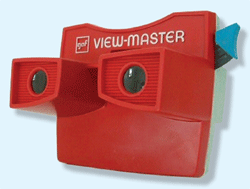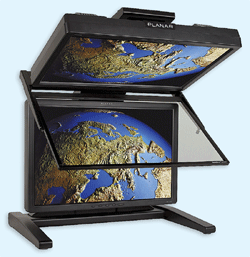New stereoscopic displays meet today’s needs for perceiving depth in imagery and complex data.
BY SCOTT ROBINSON
Planar Systems
Beaverton, OR
While most of us see the world in three dimensions, almost all of the media we receive, whether it is print, photography or video, is unfortunately a 2-D experience. Today, with interest in 3-D imaging more alive and stronger than ever, the latest stereoscopic displays address the need for perceiving depth in imagery and complex data.
Three-dimensional imaging has a rich and deep past. The Holmes Stereo Viewer was used as parlor entertainment in the late 1800s and early 1900s to view stereoscopic pictures. At the 1939 World’s Fair in New York the beloved View-Master debuted and has been a toy for all ages ever since. In the 1950s, 3-D movies took off with the first color stereoscopic feature, “Bwana Devil,” released in 1952.

Three-dimensional image viewing has entertained people since the turn of the last century.
The 1980s saw the introduction of CRT-based stereo monitors using a process in which the left- and right-eye images are displayed as separate frames sequentially. The images were synchronized in one of two ways, an active approach using fast-switching LCD shutter glasses to block the eyes sequentially in time with the left-and right-eye images.
The other approach used CRT-generated images that are circularly polarized in opposite directions by a fast liquid-crystal cell placed in front of the monitor and viewed through lightweight, circular-polarized glasses. In both designs the CRT refresh rate has to run at roughly twice the normal frame rate, or about 100 Hz, to reduce flicker.
Stereo vision today
Technology continues to improve the realism of what we see on a display in an attempt to match what we see with our eyes, as there is a growing interest in using 3-D displays for several reasons. Stereoscopic viewing is a requirement for some professional applications, and other tasks use 3-D viewing to extract information from complex visual data faster and more accurately with the potential to improve interpretation efficiency and reduce the signal-to-noise in the image.
Previously 3-D displays have been dismissed due to a lack of content, poor visual performance in the device, and viewing discomfort. The time is right for more widespread use of stereoscopic displays for reasons including: (1) computers and graphics cards have become much more powerful and affordable; (2) complex data, 3-D content, and digital imagery are widely available; (3) there is an overload of information and increasing our rate of comprehension is essential to keep up; and (4) new 3-D display technology improves performance and comfort.
Stereoscopic technologies
Some would say the perfect 3-D display would not require eyewear, and a number of companies have developed stereo display products that are glasses-free, or auto-stereo. These solutions usually cut the display resolution in half by sending all the odd display columns to one eye and the even columns to the other, requiring a user to have their head positioned in a “sweet spot.”
Other auto-stereo displays divide the display resolution up further to create “zones” where 3-D can be seen. Autostereo displays may find their niche in applications where the 3-D effect is meant to grab attention, such as signage, and there are also a large number of cell phones making use of auto-stereo displays.
Professional stereoscopic display users depend on high quality, high resolution stereo images to accurately create, view or edit 3-D data and stereo images, so alternative 3-D technologies have risen to address this need. For example, Planar Systems StereoMirror technology uses two AMLCD monitors in an up/down configuration with a beamsplitter halfway between.
A user of such a stereoscopic monitor wears polarized glasses that allow the left eye to see the lower monitor and the right eye to see the upper monitor, with the beamsplitter positioned so that the users feel like they are looking at one display. Both eyes see a continuous, flicker-free image without compromising resolution, color, contrast or the image quality that you normally see on a 2-D monitor. Although a larger solution than a comparable autostereo device, the result is a high-quality stereoscopic image that is comfortable to view.

A beamsplitter-based stereoscopic monitor offers a full-resolution image to both eyes.
Another approach to stereo viewing uses a stacked pair of liquid-crystal panels, with the first panel controlling the pixel intensity and the second controlling polarization orientation. The high-intensity backlight is collimated to reduce light leakage of adjacent pixels, and a diffuser is placed on the front of the display to widen the viewing angle from the collimated light. Each image is computed based on the stereo pair of images received, and users wear polarized glasses to separate the left and right images.
Other means to create a 3-D visual system involve two head-mounted displays to isolate the content to each eye, while others require the user to place their head in a position that segregates the two views. There are volumetric displays that can project a walk-around image into true 3-D space, and for larger audiences, front or rear projections systems are used where the left and right image are separated with frame sequencing and/or polarization.
Choosing a stereoscopic solution
First, a stereoscopic display solution has to have a good image as people who are accustomed to seeing a nice picture on their regular desktop monitor expect that same quality for a stereo 3-D image. In addition, the left and right images must be separated without sacrificing the image attributes.
Second, the display system has to be comfortable. People want to be able to view a stereo 3-D image without changing their normal display viewing behavior or being subjected to an annoyance, like heavy or clumsy glasses.
Third, a good 3-D display solution has to be easy to setup and use, with a simple interface between the computer, graphics card, and software. People use 3-D displays to view complex data and images and they should be able to focus their attention on the content rather than the means to view the content.
This is an exciting time as stereoscopic technologies continue to accelerate the adoption of 3-D in both professional and consumer application. Stereo 3-D displays have the potential to benefit medicine, geospatial intelligence, pharmaceutical development, petroleum exploration, complex visualization, architecture, simulation, remote operation and other difficult tasks.
Advertisement
Learn more about Planar Systems





